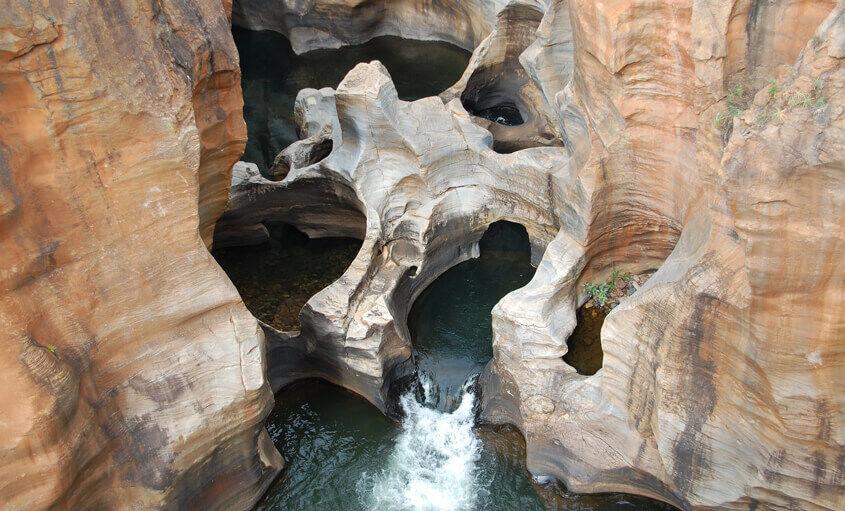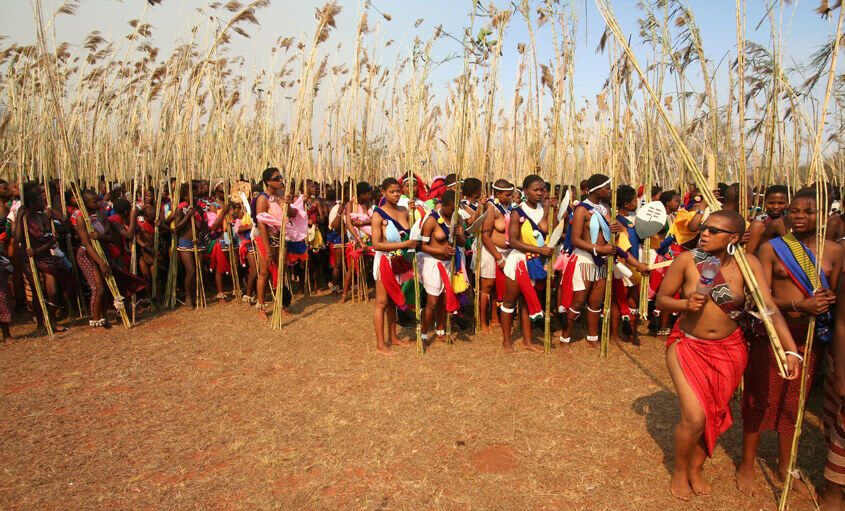Evergreen Escape has tailormade a 12-day combined culture and safari trip, which gives you the opportunity to experience Africa’s most impressive game reserve with the world’s largest concentration of wild animals, the most unique natural scenarios, as well as visits to local tribes in both South Africa, eSwatini and Lesotho.
When you have made it through passport control at the airport, your Danish Tour Leader, local guide and driver will be ready to welcome you. We continue today’s journey by driving towards the spectacular Soutpansberg mountain range in the northern Limpopo province, which is known as the gateway to the three neighbouring countries – Mozambique, Zimbabwe, and Botswana.
Arriving at our lodge, the afternoon is free to relax after a long journey. We spend the night at the 4-star hotel Shiluvari Lakeside Lodge, which is situated on 30 hectares of natural vegetation. We may be lucky to see waterbuck and kudu, which regularly visit the area.
After a good night’s sleep, it’s time for a special experience when we get to see how people live and live in this area. Because no journey to the African continent is complete until we have met the local population on their terms – an authentic encounter far removed from classic tourism. Then we spend the day in the village of Mphambo, inhabited by people from the Shangaan-Tsonga tribe.
The black South African population is divided into 4 major ethnic groups: Nguni (Zulu, Xhosa, Ndelebe and Swazi), Sotho, Venda, and Shangaan-Tsonga. In the village of Mphambo we will experience the same friendliness and hospitality that has always characterized the tribe. The men typically look after the cattle, while the women look after the cultivation of the land. When we arrive, we will meet the local chief who will introduce us to the village and its residents.
After a memorable day it is time to say goodbye to the village and drive to our lodge for the next 2 nights. We spend the night at the 4-star hotel Kubu Safari Lodge, located in a large private nature reserve just outside the Krüger National Park. While enjoying a sundowner and absorbing the day’s impressions, we may be lucky enough to see giraffes or antelopes parading by.
Today we have to get up early and have a full day’s game drive in South Africa’s largest national park, which has an area of almost 20,000 km². Krüger National Park was established in 1926 and opened its gates to the first 3 guests in 1927. In Day, the park boasts one of the world’s largest concentrations of animal species – more than 140 different mammal species, more than 100 different reptile species and more than 500 bird species.
So, on today’s game drive there is a great chance that we can experience The Big Five – the rhinoceros, the lion, the leopard, the elephant, and the buffalo. The term dates back to the 1800s, when big game was hunted on foot. The hunters judged that these five animals were the most difficult and dangerous to kill. So even though the term originates from a bygone era, nothing has changed in that it is still an achievement and requires a lot of luck to spot these five animals.
After a good night’s sleep, it’s time for a day dedicated to nature experiences. We are going out on South Africa’s most beautiful nature route – the Panorama route – in the north-eastern part of the country. The most fascinating area of the route is the spectacular Blyde River Canyon. The 25-kilometer-long and 1.4-kilometer-deep gorge is the second largest canyon in Africa and is one of nature’s great wonders on the continent.
After we have explored the natural surroundings, it is time to cross the border and continue the journey to the small kingdom of Swaziland, or as it is rightly called today, eSwatini. The country is incredibly scenic with mountains, savanna and rainforest, and despite being heavily dependent on South Africa, it has managed to preserve its distinctive culture with many colourful celebrations, dances, and rituals. We will experience the country’s proud traditions and culture up close when we go out to visit a local village in the afternoon and learn more about the local lifestyle.
After a delicious breakfast, we go to one of the lively markets where we can find homemade and handmade souvenirs. You can e.g., find Black Mamba Chili Sauce, which is made from local ingredients without the use of additives, and where you help support the local farmers with your purchase. You can also find the famous candles Swazi Candles.
After our market visit, it’s time to cross the border into South Africa and drive to Africa’s oldest nature reserve, Hluhluwe iMfolozi Game Reserve. The reserve was previously used as Zulu King Shaka’s private hunting grounds, but was established as a national park in 1895.
In the afternoon we drive to the town of Santa Lucia and get ready for a 2-hour boat cruise at iSimangaliso Wetland Park. It came, as the first area in South Africa, on UNESCO’s World Heritage List in 1999, and is the largest wetland in Africa with its 3,280 km².
After breakfast, there is an opportunity to go on a small city tour of Saint Lucia before we continue today’s journey. We are in the heart of Zululand, which today forms the north-eastern province of Kwazulu-Natal. The area is mainly inhabited by the Zulus, who are the largest tribe in South Africa, numbering a mere 11 million people. Zulu actually means “sky” and thus the Zulus are the “people of the sky”. Their heyday began in 1816 with the appointment of Shaka as their king.
We will first go on a tour of the village, where we will, among other things, visits a school and gets a feel for how teaching is done in this part of the world. Next, we are going to have an experience out of the ordinary when we are going to visit a medicine man or traditional healer and get a unique introduction to the traditional religion linked to the Zulu people. Although the majority are Christians, traditional religion still plays a huge role.
After a rare insight into a world where faith, superstition and culture go hand in hand as a treatment method, it’s time to say goodbye to our Sangoma and head to our hotel for the night.
After breakfast, we will go out to visit Fort Nongqayi, which was built by the British to house the local police officers (Nongqayi means in the local language “light is shed on the matter”). Construction began in 1883, but the British colonial power ran out of money along the way, so the fort only has 3 of the planned 4 corner towers. Today the fort is an interesting museum dealing with the moving history between the British and the Zulus.
After the visit, we continue our journey to the Nelson Mandela Capture Site Memorial. Mandela, the now deceased former president of South Africa, achieved international recognition for his efforts to establish racial, social and political equality in a South Africa ravaged by the damaging effects of the apartheid regime.
After the visit, we continue our journey through the country to one of the most beautiful mountain ranges in the world – the Drakensberg. The mountain range covers an area of 2,500 km² and the highest point Thabana Ntlenyana (located in Lesotho) reaches a whopping 3,482 meters into the air.
After breakfast, we drive through the impressive mountain landscape of the Royal Natal National Park on our way to the Kingdom of Lesotho. In the spectacular landscape, the Amphitheatre is one of the biggest attractions.
We cross the border to the small, beautiful kingdom of Lesotho, which is the highest country in the world. The lowest point in the country is approx. 1,450 meters above sea level and as much as 80% of the country lies above 1,800 meters above sea level, which is why the country is also called the “Kingdom of the Sky”. The country, with a population of 2.1 million inhabitants and a total area of 30,355 km² (the size of Belgium), is completely surrounded by South Africa.
We spend the night in the remote village of Malealea, tucked away in the Makhomalong Valley at the foot of the majestic Maloti Mountains in southwestern Lesotho. Surrounded by a landscape of rolling hillsides, tall aloe vera plants and the reddish brown glow that shines over the mountains from the sun, this very rural village is the ideal place to enjoy nature and silence.
After a wonderful night’s sleep in the fresh mountain air, it’s time to get out and experience how the local people live and live. We are going on a trip around one of the small villages, where we will be introduced to everyday life. We will see the local well from which water is drawn, we will see how the local women brew beer, we will visit their homes and we will visit a school. We will experience poverty, but at the same time a population full of hope, resilience, dreams and laughter.
The rest of the afternoon is at your disposal, where you can relax and enjoy the surroundings, or do one of the following activities (at your own expense).
In the evening, when the sun begins to slip behind the Maloti mountains and the light blue-sky melts into pink, a local choir and band will perform for us. Music is as important a part of life for the Basotho as air is, and they want to share it with us. Their songs are emotional and inspired by life in the kingdom of the clouds.
After a wonderful breakfast, it is time to say goodbye to Lesotho and cross the border north to South Africa. The destination for today’s journey is South Africa’s administrative capital, Pretoria. The city is also known as “Jacaranda City”, when the streets are lined purple from the many beautiful trees in September to November.
The guided sightseeing tour around the city takes us back in history. We must, among other things, experience the Voortrekker Monument, the Union Buildings and the Krüger House.
After breakfast we drive to Johannesburg. Without exaggeration, Johannesburg can be said to be the city of contrasts. “Joburg”, as it is often referred to, is South Africa’s largest city with a population of approx. 6.3 million people.
We are going to visit the famous and infamous township Soweto (Southwest Township) and get a little insight into the daily life here. It is estimated that there are approx. 2 million people in the urban area, which is about 65 km² in size.
After lunch, we finish the day’s sightseeing with a visit to the Apartheid Museum. Founded in 2001, the museum is recognized as the leading museum in the world dealing with the history of South Africa from the 20th century.
Enjoy the last morning atmosphere in Johannesburg. Take a little walk in the area or buy the last souvenirs before we get ready to go to OR Tambo International Airport to start our journey home to Denmark. Tired, but filled with lots of lovely holiday memories, new friendships and, of course, unique spot shots.
Get all the help, call +254 791 918888 or email us at info@evergreen-escape.com.







Whether you’re planning a safari, or have a question about traveling to Africa, our Travel Specialist would love to respond to your inquiries. Drop us a message.
Thank you for considering this safari. We look forward to having you on this wonderful safari. Complete the form below and we will be in touch to finalise arrangments.